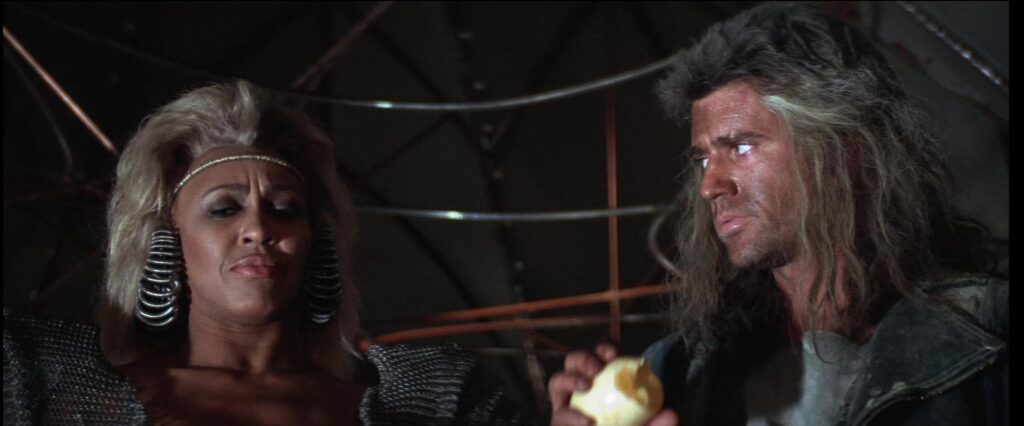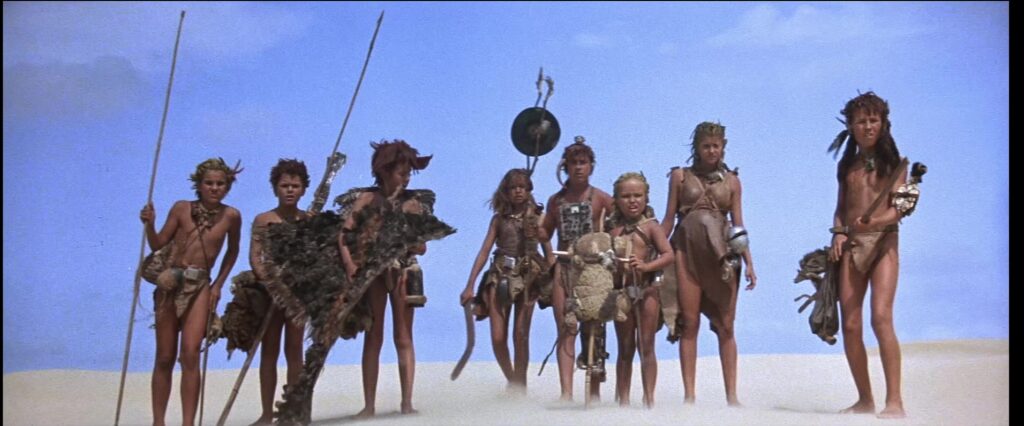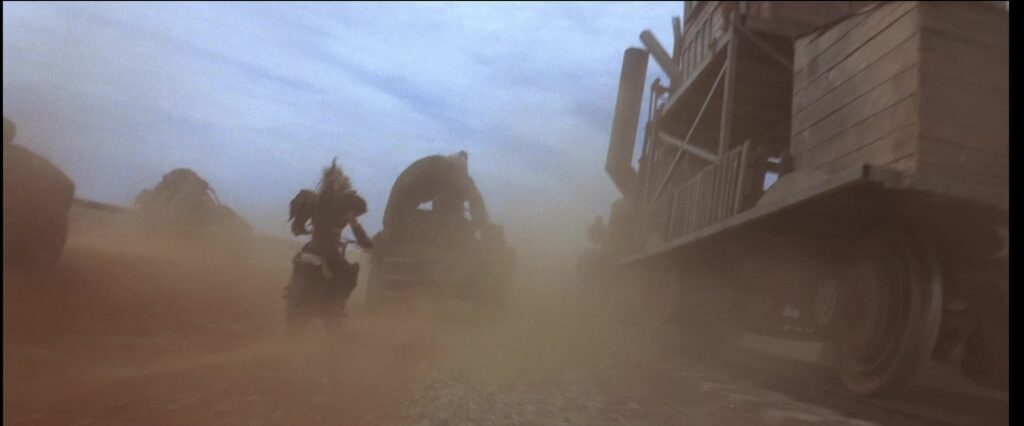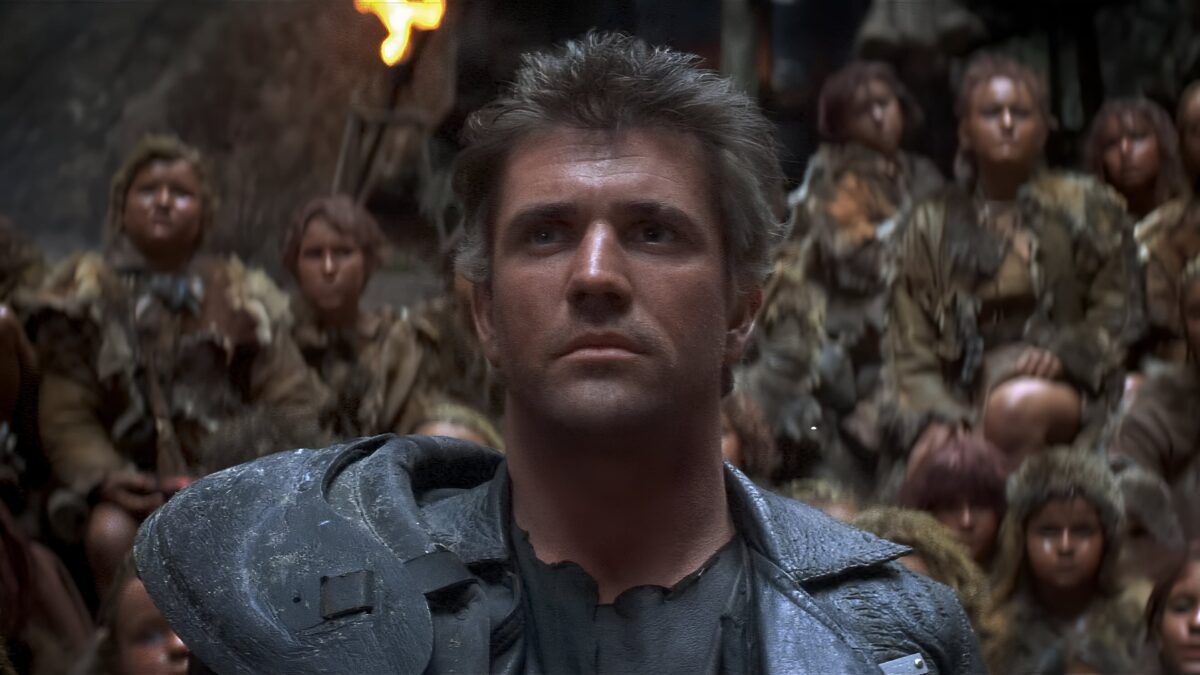"This nobody had a chance to be somebody"
I have never encountered a trilogy quite like the three original Mad Max films. It almost feels disingenuous to call them a trilogy. Certainly some commonalities tie them together: They share high-level setting elements (”post-apocalyptic, fuel-shortage Australia”). Each film climaxes with a vehicle chase down a desolate road. George Miller’s formidable creativity as director, writer, and all-around visionary guides each outing. Mel Gibson stars at the titular Max Rockatansky. All three also each take place in a ramshackle, soldered-together, low-exposition cinematic world.
But these films are barely even the same genre, let alone the same continuous narrative. If their worldbuilding style is consistently haphazard in spirit, each world itself is completely distinct. The tone of each film is such a sharp left turn from the previous that either Miller has an inherent creative aversion to repeating himself, or else he aggressively forced himself to avoid any type of sequelitis from picture to picture. Had a fourth movie in the series had come out in the ‘80s, it could just as well have been a musical, or a romantic melodrama, or a space opera, or a slasher. Nothing would have surprised me.
Whereas the original Mad Max is a quirky microbudget Ozploitation number set near present day in semi-rural Australia, and Mad Max 2 is a dusty, dystopian hero’s quest, Mad Max: Beyond Thunderdome is stranger than either. In fact, it’s basically two separate, strange films in one: The first half is a grimy gladiator picture; the second half is a wilderness survival story co-starring knockoff Lost Boys; and the climax is a heist chase that mashes them together. Miller continues to pull weird strands of subgenres into his stories as if it’s the most intuitive narrative mashup in the world.

The first half of this film is as good or better than the climax of Mad Max 2 (high praise), but in different ways: The series’ mucky worldbuilding reaches an apex (or, technically, a trench). It sounds strange on paper, but it’s somehow even more bizarre and flavorful in action than in text: Max (Gibson) enters the fallout shelter-esque civilization called Bartertown, led by Aunty Entity (Tina Turner; yep!) in search of his stolen vehicle. As you’d guess from its name, Bartertown requires you bring goods or services to exchange for its economy. Max proffers his badassery as his commodity.
Aunty Entity, impressed, shows Max how Bartertown operates: its electricity comes from methane generated in an underground animal farm run by “Master Blaster,” a two-part team consisting of a shrunken genius, Master (Angelo Rossitto) and his dimwitted hulking assistant, Blaster (Paul Larsson). We learn from Aunty Entity that Master has become too powerful in the Bartertown hierarchy, and she recruits Max to kill Blaster so that the frail Master can be more easily manipulated… or something like that. It’s not an entirely coherent setup, though it’s deeply fun to watch, as it features some phenomenal production and set design. As much as Mad Max 2 offered a quintessential, hugely influential vision of one post-apocalyptic setting — the desolate, retro-indutrial, lawless ruins — Mad Max: Beyond Thunderdome does the same in a totally different post-apocalyptic setting — the underground, insulated, hyper-regimented, nightmare society. It’s a real achievement of imagination and design. The climax of this first act is absolutely terrific: a cage fight and escape sequence that shows Miller’s take on hand-to-hand combat is more fever-dreamy than his vehicle chases, but just as inspired.

The second half of the film is a rather abrupt shift out of the Bartertown bowels into desert wilds, where Max meets a feral society of children. Across a dozen or so reviews of this film, I’ve found a consensus that this second half of the film outright sucks, and I disagree. It is lesser than the film’s first half, but still a fully-formed world and encounter for Max. It just lacks some of the divine spark of the previous movie-and-a-half. There’s something slightly off about it, like Miller and his team needed a few more drafts on the script to brainstorm some wrinkles for this faux-primitive society of Aboriginal-coded children. But I really love the on-location vistas, especially the sand that flows like water and swallows characters like a murky swamp.
The climax involves a return to Bartertown and, because this is indeed a Mad Max film, a wild, prop-filled, nerve-rackingly physical vehicle chase. This one includes planes, trains, and automobiles for some variety, but it is unfortunately not quite as sublime as the analogous sequence of Mad Max 2, which borders into masterpiece territory.
Mad Max: Beyond Thunderdome’s production was tinged with tragedy: Byron Kennedy, Miller’s producer and creative partner since they bootstrapped Mad Max together in the late ‘70s, died in a helicopter crash. This so deeply affected Miller that he withdrew from the making of the film for awhile, handing some directorial duties to the stage and TV director George Ogilvie.

The film is ultimately less than the sum of its parts, both because of its discordant structure of two mostly unrelated halves, and because there’s a certain sparkle and passion missing, especially, as noted, in the second half. Much of this can probably be attributed to Miller’s disengagement during parts of the production; or maybe the Mad Max magic had stretched to its limit in three outings produced within five years (released within six). It’s still entertaining and satisfying and memorable, easily outstripping the original as a standalone film, but a diminishing return following the electric Part 2.
After Beyond Thunderdome, Mad Max would disappear for three decades. But, in one of the great comeback stories of blockbuster cinema history — and one of the only scenarios where a legacy sequel outstrips the originals — the franchise would return in the seismic Mad Max: Fury Road in 2015. Hold onto your butts.
- Review Series: George Miller
Is It Good?
Good (5/8)
Dan is the founder and head critic of The Goods. Follow Dan on Letterboxd. Join the Discord for updates and discussion.


5 replies on “Mad Max: Beyond Thunderdome (1985)”
Worth noting, I think, is that this is the only Mad Max movie out of five that’s rated PG-13. Feels like they were going for a sort of Amblin-esque, mid-80’s, family-blockbuster vibe to this one.
And that’s fine, as these things go (I actually like this movie well enough: 5 out of 8 feels right). But it does lack the edge of the previous two.
Myself, I continually forget that Fury Road and Furiosa were rated R. I’m actually not sure why they are. (In fairness, it’s not just those two, I’m not-infrequently surprised and perplexed to discover a movie’s rated R. “What, did they say ‘fuck’ three times?” I suppose I’d be pretty permissive if I were on the ratings board.)
Anyway, guess you and Dan don’t need another hero? Or at least not as much as me. I’ve always liked Thunderdome, it’s a fun romp.
Oh, wait. The dairy farm. Right.
“A fun romp” seems right. You have it as a 7/10 on Kinemalogue, and on a 10 point scale I’d probably be at 6/10, so we’re not far off, even if my tone is a bit cynical.
Yeah, the second half especially feels like a tribute to Spielberg or Goonies or something.